Few words conjure up more fear, awe, and inspiration than the word “Cobra”. No, we’re not
talking about the deeply feared species of snake that terrorizes tropical climates all
over the world and can get up 19 feet long. We’re talking about hardcore,
performance-enhanced muscle cars and sports cars from the minds of legends like Carroll
Shelby and Ford’s very own Special Vehicle Team. Few things make the hearts of
enthusiasts skip a beat more than a great vehicle made even better and the Mustang SVT
Cobra was one of the best examples of what happens when the right people come together
at the right time. That’s right! Ford had their very own version of the famous Cobra nameplate that made its way
to the scene way back in 1993, consequently, the very last year of the famous Fox Body
Mustang that would define an entire generation of enthusiasts. We’re going to cover everything you need to know about the Ford Mustang SVT Cobra. From the
introduction in 1993, all the way through to its demise in 2004. There is a fantastic
story and deep history behind these awesome machines that are just begging to be told:
1993 Fox Body Mustang SVT Cobra
1994-1998 SN95 SVT Mustang Cobra
1999-2001 “New Edge” SVT Mustang Cobra
2003-2004 “Terminator” SVT Mustang
Cobra
Cobra R Models
The 1993 Mustang SVT Cobra made its debut in 1993 at the Chicago Auto Show to a crowd of
eager enthusiasts and Mustang fanatics alike. Ford had just launched the now-ubiquitous
SVT division on the heels of the defunct SVO group and the 1993 Cobra was their
opportunity to showcase a division that would bring performance, substance, exclusivity,
and value to the Blue Oval. Joining the Mustang on stage at the Chicago Auto Show was
the F-150 Lightning truck, yet another incredibly ambitious project from the men and
women at Ford. 1993 was the last year of the Fox Body Mustang; a vehicle that had revived and cemented Ford
as a leader in muscle car technology, affordability, and style. Although it looked like
a complete package to consumers, insiders at Ford completed the development of the Cobra
in record time. Rather than source new parts, Ford decided to roll with a modified 5.0
V-8 from the Mustang GT that utilized GT-40 heads and lower intake, unique upper intake,
unique valves, and free-flowing exhaust. The Tremec 5-speed manual offered a hefty shift
weight and internals that could handle this vehicle’s performance mission. Underneath, bigger brakes and uniquely tuned suspension helped the 1993 Cobra remain
compliant in the corners, while the huge (for the time) 17 inch, propeller inspired
wheels kept things planted. Unique exterior and interior styling cues distinguished the
Cobra from lesser Mustangs. The front fascia and SVO style tail lamp array are some of
the most unique pieces of the exterior design. Inside, not too many changes were present
in the already sporty cockpit. 1994 was going to bring with it an all-new Mustang and an all-new Cobra to boot. For 1994, Ford brought an entirely enhanced Mustang to market. Internally dubbed the SN95,
this Mustang continued its approach to affordable, attainable performance. The Cobra
model would soldier on with minimal changes to its GT-40 enhanced powertrain but clever
tuning from the SVT team would see horsepower jump to 240 from 235 and performance
figures that would also incrementally increase. Much like the 1993 model, there was a host of interior and parts that visually separated the
1994 Cobra from a standard GT model: What made this generation of Cobra so unique was the introduction of a convertible Cobra for
the first time since 1970. Debuting as a pace car for the 1994 Indianapolis 500, Ford
celebrated the 30th anniversary of Mustang with a trio of unique Cobras. Each of the
three pace cars was modified by Jack Roush for pace-car duty, and eventually, Ford would
go on to sell a replica of the pace car in extremely limited quantities. Only 1000 were
produced! 1996 saw a major change to the Cobra lineup with the adoption of Ford’s DOHC, modular V-8
architecture. The “Romeo Engine,” as it came to be known, produced a stout 305
horsepower and was hand-built by two Ford techs. Each Romeo Engine utilized an aluminum
block that was cast by Italian firm, Teksid, who built engines for championship-winning
Formula 1 teams. The Romeo was an incredible engine and would go on to serve as the
basis for future generations of Cobra’s and non Cobra’s alike. Minimal changes would persist through subsequent years until an introduction of an all-new
Mustang in 1999 that would be dubbed the “New Edge” Mustang. The now semi-infamous “New Edge” Mustang made its debut in 1999 and along with this all-new
Mustang, came an all-new SVT Cobra that would introduce a unique suspension component
that would take the SVT from mere muscle car to full-blown sports car. Ford’s design
team pulled in the sharp design cues from the original Mustang and modernized their
design to include creases, sharp lines, and flat angles. This was a huge departure from
the previous generation, although underneath, the New Edge Mustang was based on the SN95
of the previous generation. The biggest news was out back where the Ford team ditched the solid axle of lesser Mustangs
and installed (for the first time ever) a fully independent rear suspension or IRS. The
IRS brought the Mustang into the 21st century and set a new benchmark for what a muscle
car could be. This was no straight line only ‘Stang! It was designed to go around
corners like a European sports car while still being propelled by the beating heart of
an American Pony car. SVT also moved the Cobra to whopping 13” Brembo brakes to keep all
this speed in check. Speaking of beating hearts, how does 320 raging horsepower sound? The magicians at Ford's SVT
extracted another 15 ponies out of the DOHC modular V-8 by utilizing race car technology
known as “tumble port” heads. Inside was an all-new interior set off with features like
standard leather and upgraded “Mach” stereo systems. All in all, this was an incredible
set of upgrades that would set the basis for Mustangs for years to come. A fantastic side story is the 2000 model that never was. When introduced in 1999, Cobra
owners were disgruntled because their newer, more powerful Cobra was producing 0-60
times SLOWER than the 1998 model. Owners took to shops and dyno tests showed that the
1999 Cobra was indeed only producing around 285 horsepower, which was well shy of its
320 hp rating. As a result, Ford pulled all unsold 1999 models from the lot and recalled
all those that were sold to fix the issue. Yikes! The Cobra skipped the entire next production year for all but the Mustang R variant to ensure
that the motors in their vehicles were putting out a true 320 HP at the crank. Although the 2003 Mustang may look similar to the 1999 model on the outside, what made it
really special was under the hood. Dubbed “The Terminator”, the SVT strapped an Eaton
Supercharger to the already incredibly powerful Cobra V-8 to produce one of the fastest
Mustangs that Ford had ever produced. Power was a magical 390 horsepower and 390 lb. ft.
of street ripping torque and it was sent through a standard 6-speed manual gearbox. SVT offered the 2003 - 2004 Cobra in both Coupe and Convertible variants along with a
slew of special edition packages and colors such as the highly sought after
“mystichrome” color for 2004. 2004 was the last model year for the SN95 based Mustang
and it was also the last year that Mustangs were built in their birthplace; Dearborn,
Michigan. As such, the 2004 models are especially coveted by collectors across the world
and many ended up in personal collections or museums. The Cobra name was also on the way out, and would eventually be replaced in spirit by the
Shelby Mustangs of the mid-’00s and beyond. The “R” stands for Race and these 3 Cobra variants were purpose-built by the team at SVT to
hit the track and dominate; right off the factory floor. The first and last Fox Body Cobra R was an extremely exclusive build with only 107 models
being produced. Ford simultaneously beefed up the hardware for the riggers on the track,
while also shedding 450 pounds via deletion of everything from the radio and air
conditioner to the rear seats. The chassis was stiffened via X braces, new Eibach
springs, and fully adjustable Koni shocks were placed at all 4 corners with huge
Kelsey-Hayes vented rotors up front and out back. Collectors and museum owners almost
immediately snatched these up, and hardly any were actually raced. Ford was not happy
about this. Ford’s extremely popular SN95 Mustang was the basis for the 1995 Cobra R model. Ford dropped
the 5.0 and instead went for a modified version of the 5.8L Windsor V-8 and power was a
prodigious 300 horsepower flat, flowing through a Tremec 5 speed. Many of the same
weight-saving tricks were employed on the 1995 Cobra R as the original 1993. Crucially,
unique to the 1995 model was that Ford required buyers to have a valid competition
license or own a race team to even purchase the Cobra R! They were upset the 1993 R had
been picked up by collectors and wanted to ensure that didn’t happen again. This R was
ready for the track. In an interesting twist, the only 2000 Cobra model is the R variant! The list of performance
enhancements includes Brembo brakes, competition-spec BFG tires, and a massive 5.4 L V-8
under the hood that produced a stout 385 horsepower. If that displacement sounds
familiar, that’s because Ford pulled the iron “Triton” block in for duty from their very
own F-150 truck! Power was put down through a close-ratio 6-speed manual gearbox from
Getrag (a first for a Mustang). The last of the R models also utilized a functional
spoiler and Eibach springs and shocks to keep things in check. This was an incredible
performance car for the time and it is still one of the most sought after variants of
the Mustang. Source: Ford Performance | Road & TrackMustang SVT Cobra: Everything You Need To Know
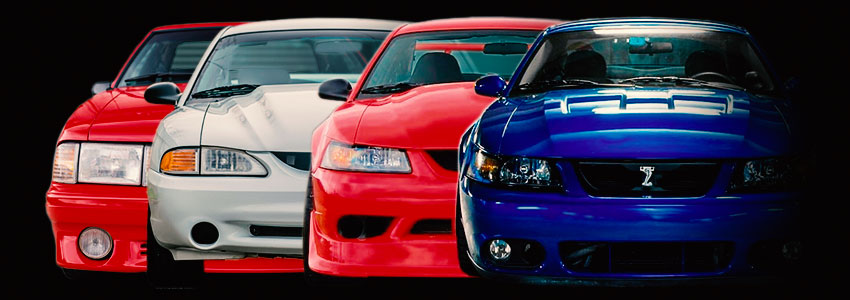
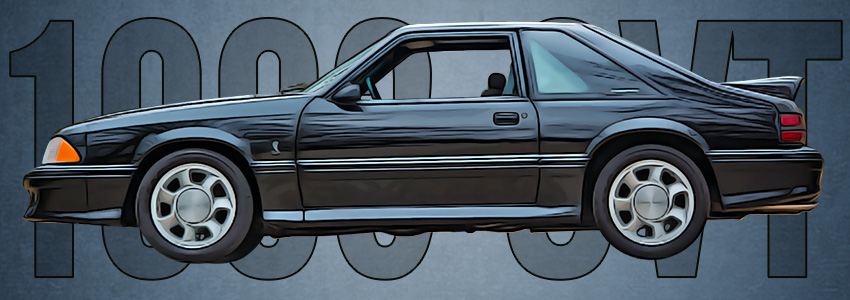
1993 Fox Body Mustang SVT Cobra
1993 Mustang SVT Cobra: The Numbers
Vehicle Specification
Statistic
Engine
Type
90-degree, OHV Windsor V-8
Displacement
5.0L / 302 CID
Horsepower
235 hp @ 4600 rpm
Torque
280 lb.-ft. @ 4000 rpm
Bore x Stroke
4.0 in. x 3.0 in.
Compression
9.0:1
Suspension
Front
Modified MacPherson strut-type, coil springs, anti-roll bar
Rear
Rigid axle located by four trailing links, coil springs, anti-roll
bar
Brakes
Front
10.84 in. vented disc
Rear
10.07 in. vented disc
ABS
N/A
Wheels/Tires
Wheels
17 x 7.5 in cast aluminum
Tires
Goodyear P245/45ZR-17 BSW
Performance
0-60 MPH
5.9 seconds
60-0 MPH Braking
140 feet
1/4-mile @ MPH
14.5 sec @ 98 mph
Production
Black
1,854
Vibrant Red
1,784
(1,775 Clearcoat / Paint Code ES)
(9 Non-Clearcoat / Paint Code EY)
Teal
1,355
Total Produced
4,993
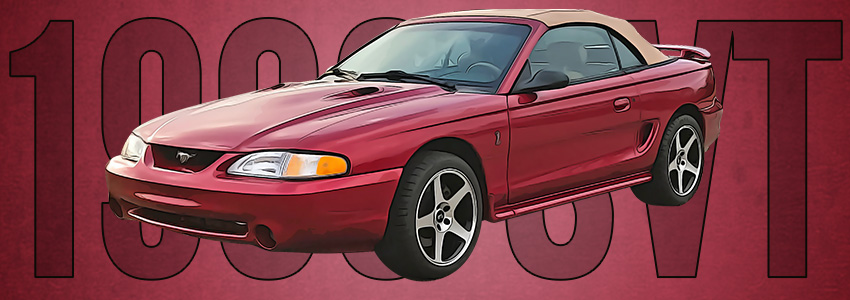
1994 - 1998 SN95 SVT Mustang Cobra
1995 Mustang SVT Cobra: The Numbers
Vehicle Specification
Statistic
Engine
Type
90-degree, OHV Windsor V-8
Displacement
5.0L / 302 CID
Horsepower
240 hp @ 4800 rpm
Torque
285 lb.-ft. @ 4000 rpm
Bore x Stroke
4.0 in. x 3.0 in.
Compression
9.0:1
Suspension
Front
Modified MacPherson strut type with separate spring on lower arm,
400 lbs./in. linear-rate coil springs, 25mm stabilizer bar
Rear
Rigid axle, four trailing links, two leading hydraulic links, 160
lbs./in. linear-rate coil springs, 27mm stabilizer bar
Brakes
Front
13 in. vented disc
Rear
11.65 in. vented disc
ABS
Power Assist, four wheel brakes with anti-lock
Wheels/Tires
Wheels
17 x 8 in. 5-spoke cast aluminum
Tires
Goodyear Eagle GS-C P255/45ZR-17
Performance
0-60 MPH
6.3 seconds
60-0 MPH Braking
140 feet (Est.)
1/4-mile @ MPH
14.1 seconds @ 101 mph
Production
Red Coupe
1,908
Red Convertible
1,000
Black Coupe
1,795
White Coupe
1,306
Total Coupes Produced
5,009
Total Convertibles Produced
1,000
(Indianapolis 500 Pace Car Replicas)
Total Produced
6,009
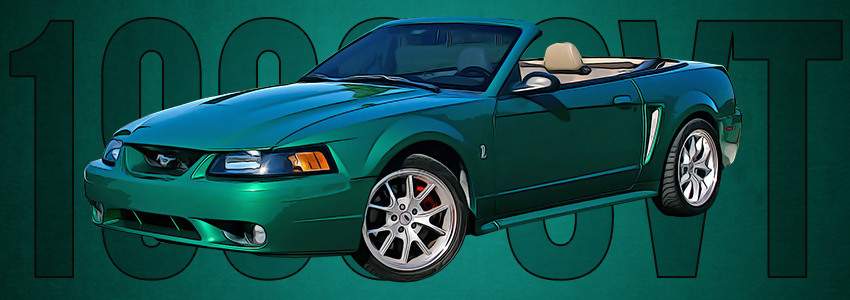
1999 - 2001 “New Edge” SVT Mustang Cobra
1999-2001 Mustang SVT Cobra: The Numbers
Vehicle Specification
Statistic
Engine
Type
90-degree, DOHC 32-Valve V-8
Displacement
4.6L / 281 CID
Horsepower
320 hp @ 6000 rpm
Torque
317 lb.-ft. @ 4750 rpm
Bore x Stroke
3.55 in. x 3.54 in.
Compression
9.85:1
Suspension
Front
Modified gas-charged MacPherson strut type with separate 500 lb./in.
spring on lower arm, 29mm tubular stabilizer bar
Rear
Multi-link independent, steel upper control arm, fixed toe-control
tie rod, aluminum spindle, gas-charged tubular shock absorber,
470 lb./in. coil spring, 26mm tubular stabilizer bar
Brakes
Front
13 in. vented Brembo disc, PBR twin-piston caliper
Rear
11.65 in. vented disc, single-piston caliper
ABS
Three channel, four-sensor ABS system, linked to all-speed traction
control
Wheels/Tires
Wheels
17 x 8 in. 5-spoke forged aluminum
Tires
BFGoodrich Comp T/A P245/45ZR-17
Performance
0-60 MPH
5.4 seconds
60-0 MPH Braking
127 feet
1/4-mile @ MPH
13.8 seconds @ 102 mph
Production
Black Coupes
1,619
Black Convertibles
1,755
Red Coupes
1,219
Red Convertibles
1,251
White Coupes
794
White Convertibles
731
Green Coupes
408
Green Convertibles
318
Total Coupes Produced
4,040
Total Convertibles Produced
4,055
Total Produced
8,095
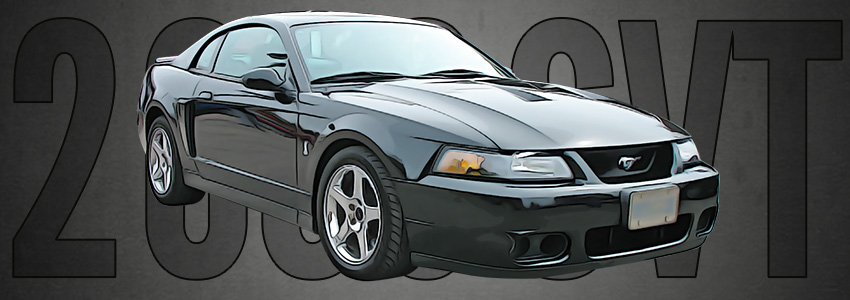
2003 - 2004 “Terminator” SVT Mustang Cobra
2003-2004 Mustang SVT Cobra: The Numbers
Vehicle Specification
Statistic
Engine
Type
90-degree, DOHC 32-Valve supercharged V-8
Displacement
4.6L / 281 CID
Horsepower
390 hp @ 6000 rpm
Torque
390 lbs.-ft. @ 3500 rpm
Bore x Stroke
3.55 in. x 3.54 in.
Compression
8.5:1
Suspension
Front
Modified MacPherson strut system gas-charged Bilstein monotube
dampeners and separate 600 lb./in. (500 lb./in. on convertible)
spring on lower arm, 29mm tubular stabilizer bar
Rear
Multi-link independent, cast-iron upper control arm, aluminum lower
control arm, gas-charged Bilstein monotube shock absorbers, 600
lb./in. (470 lb./in. on convertible) coil spring, 26mm tubular
stabilizer bar
Brakes
Front
13 in. vented Brembo disc, PBR twin-piston caliper
Rear
11.65 in. vented disc, single-piston caliper
ABS
Four channel, four-sensor ABS system
Wheels/Tires
Wheels
17 x 9 in. 5-spoke cast aluminum
Tires
Goodyear Eagle F1 P275/40ZR-17
Performance
0-60 MPH
4.8 seconds
60-0 MPH Braking
116 feet
1/4-mile @ MPH
13.01 seconds @ 110.7 mph
Production
Black Coupes
2,251
Black Convertibles
1,679
Blue Coupes
1,052
Blue Convertibles
355
Silver Metallic Coupes
992
Silver Metallic Convertibles
548
Redfire Metallic Coupes
955
Redfire Metallic Convertibles
610
Dark Shadow Grey Coupes
851
Dark Shadow Grey Convertibles
446
Torch Red Coupes
638
Torch Red Convertibles
582
Oxford White Coupes
621
Oxford White Convertibles
308
Zinc Yellow Coupes
490
Zinc Yellow Convertibles
319
Mineral Gray Coupes
302
Mineral Gray Convertibles
154
Satin Silver Coupes
242
Satin Silver Convertibles
81
Total Coupes Produced
8,394
Total Convertibles Produced
5,082
Total Produced
13,476
SVT Cobra R Models
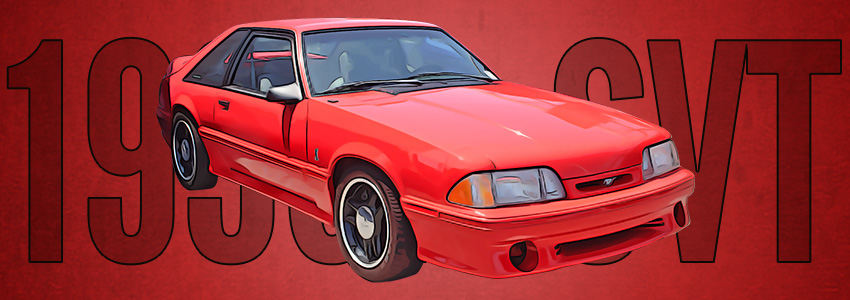
1993 Mustang SVT Cobra R
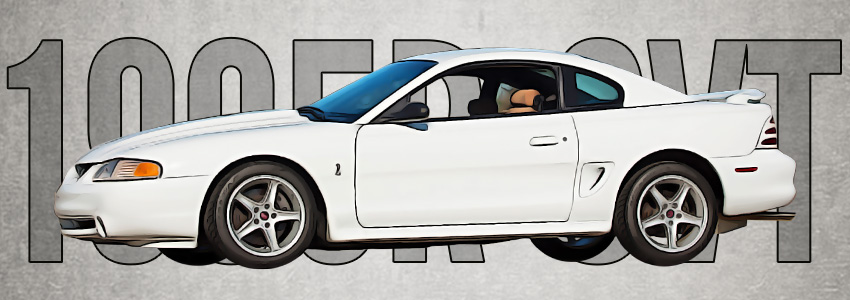
1995 Mustang SVT Cobra R

2000 Mustang SVT Cobra R
Related Articles




